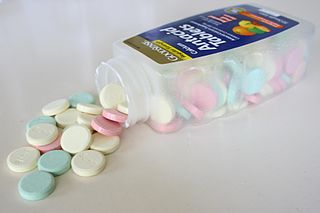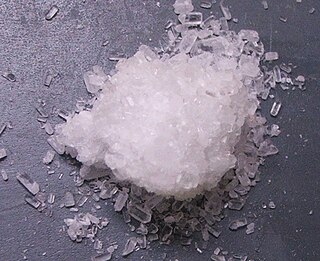Related Research Articles

An antacid is a substance which neutralizes stomach acidity and is used to relieve heartburn, indigestion, or an upset stomach. Some antacids have been used in the treatment of constipation and diarrhea. Marketed antacids contain salts of aluminum, calcium, magnesium, or sodium. Some preparations contain a combination of two salts, such as magnesium carbonate and aluminum hydroxide.

Magnesium is a chemical element; it has symbol Mg and atomic number 12. It is a shiny gray metal having a low density, low melting point and high chemical reactivity. Like the other alkaline earth metals it occurs naturally only in combination with other elements and almost always has an oxidation state of +2. It reacts readily with air to form a thin passivation coating of magnesium oxide that inhibits further corrosion of the metal. The free metal burns with a brilliant-white light. The metal is obtained mainly by electrolysis of magnesium salts obtained from brine. It is less dense than aluminium and is used primarily as a component in strong and lightweight alloys that contain aluminium.

The alkaline earth metals are six chemical elements in group 2 of the periodic table. They are beryllium (Be), magnesium (Mg), calcium (Ca), strontium (Sr), barium (Ba), and radium (Ra). The elements have very similar properties: they are all shiny, silvery-white, somewhat reactive metals at standard temperature and pressure.

Magnesium sulfate or magnesium sulphate is a chemical compound, a salt with the formula MgSO4, consisting of magnesium cations Mg2+ (20.19% by mass) and sulfate anions SO2−4. It is a white crystalline solid, soluble in water but not in ethanol.

Magnesium carbonate, MgCO3, is an inorganic salt that is a colourless or white solid. Several hydrated and basic forms of magnesium carbonate also exist as minerals.

Barium hydroxide is a chemical compound with the chemical formula Ba(OH)2. The monohydrate (x = 1), known as baryta or baryta-water, is one of the principal compounds of barium. This white granular monohydrate is the usual commercial form.
ATC code A12Mineral supplements is a therapeutic subgroup of the Anatomical Therapeutic Chemical Classification System, a system of alphanumeric codes developed by the World Health Organization (WHO) for the classification of drugs and other medical products. Subgroup A12 is part of the anatomical group A Alimentary tract and metabolism.
ATC code B03Antianemic preparations is a therapeutic subgroup of the Anatomical Therapeutic Chemical Classification System, a system of alphanumeric codes developed by the World Health Organization (WHO) for the classification of drugs and other medical products. Subgroup B03 is part of the anatomical group B Blood and blood forming organs.

Calcium lactate is a white crystalline salt with formula C
6H
10CaO
6, consisting of two lactate anions H
3C(CHOH)CO−
2 for each calcium cation Ca2+
. It forms several hydrates, the most common being the pentahydrate C
6H
10CaO
6·5H
2O.
Firming agents are food additives added in order to precipitate residual pectin, thus strengthening the structure of the food and preventing its collapse during processing.
Magnesium compounds are compounds formed by the element magnesium (Mg). These compounds are important to industry and biology, including magnesium carbonate, magnesium chloride, magnesium citrate, magnesium hydroxide, magnesium oxide, magnesium sulfate, and magnesium sulfate heptahydrate.

Calcium gluconate is the calcium salt of gluconic acid and is used as a mineral supplement and medication. As a medication it is used by injection into a vein to treat low blood calcium, high blood potassium, and magnesium toxicity. Supplementation is generally only required when there is not enough calcium in the diet. Supplementation may be done to treat or prevent osteoporosis or rickets. It can also be taken by mouth but is not recommended for injection into a muscle.

Magnesium citrates are metal-organic compounds formed from citrate and magnesium ions. They are salts. One form is the 1:1 magnesium preparation in salt form with citric acid in a 1:1 ratio. It contains 11.33% magnesium by weight. Magnesium citrate is used medicinally as a saline laxative and to empty the bowel before major surgery or a colonoscopy. It is available without a prescription, both as a generic and under various brand names. It is also used in the pill form as a magnesium dietary supplement. As a food additive, magnesium citrate is used to regulate acidity and is known as E number E345.

Magnesium gluconate is a compound with formula MgC12H22O14. It is the magnesium salt of gluconic acid.
Magnesium aspartate is a magnesium salt of aspartic acid. It is used as a mineral supplement, and as an ingredient in manufacturing of cosmetics and household products.
Magnesium glycinate, also known as magnesium diglycinate or magnesium bisglycinate, is the magnesium salt of glycine, and is sold as a dietary supplement. It contains 14.1% elemental magnesium by mass.

Calcium supplements are salts of calcium used in a number of conditions. Supplementation is generally only required when there is not enough calcium in the diet. By mouth they are used to treat and prevent low blood calcium, osteoporosis, and rickets. By injection into a vein they are used for low blood calcium that is resulting in muscle spasms and for high blood potassium or magnesium toxicity.

Magnesium sulfate as a medication is used to treat and prevent low blood magnesium and seizures in women with eclampsia. It is also used in the treatment of torsades de pointes, severe asthma exacerbations, constipation, and barium poisoning. It is given by injection into a vein or muscle as well as by mouth. As epsom salts, it is also used for mineral baths.
Radium compounds are compounds containing the element radium (Ra). Due to radium's radioactivity, not many compounds have been well characterized. Solid radium compounds are white as radium ions provide no specific coloring, but they gradually turn yellow and then dark over time due to self-radiolysis from radium's alpha decay. Insoluble radium compounds coprecipitate with all barium, most strontium, and most lead compounds.
References
- 1 2 "The Top 300 of 2021". ClinCalc. Archived from the original on 15 January 2024. Retrieved 14 January 2024.
- ↑ "Magnesium - Drug Usage Statistics". ClinCalc. Retrieved 14 January 2024.
- ↑ "Magnesium Salts - Drug Usage Statistics". ClinCalc. Retrieved 14 January 2024.
- 1 2 Blitz M, Blitz S, Hughes R, Diner B, Beasley R, Knopp J, et al. (July 2005). "Aerosolized magnesium sulfate for acute asthma: a systematic review". Chest. 128 (1): 337–344. doi:10.1378/chest.128.1.337. PMID 16002955.
- ↑ "Committee Opinion No 652: Magnesium Sulfate Use in Obstetrics". Obstetrics and Gynecology. 127 (1): e52 –e53. January 2016. doi:10.1097/AOG.0000000000001267. PMID 26695587. S2CID 33483604.
- ↑ Crowther CA, Brown J, McKinlay CJ, Middleton P (August 2014). "Magnesium sulphate for preventing preterm birth in threatened preterm labour". The Cochrane Database of Systematic Reviews (8): CD001060. doi:10.1002/14651858.CD001060.pub2. PMC 10838393 . PMID 25126773.
- 1 2 3 Ehrlich SD (17 June 2011). "Magnesium". at University of Maryland Medical Center (UMMCb. Archived from the original on 27 January 2011.
- ↑ "Health Risks from Excessive Magnesium". Office of Dietary Supplements (ODS). U.S. National Institutes of Health (NIH).
- ↑ Omu AE, Al-Harmi J, Vedi HL, Mlechkova L, Sayed AF, Al-Ragum NS (2008). "Magnesium sulphate therapy in women with pre-eclampsia and eclampsia in Kuwait". Medical Principles and Practice. 17 (3): 227–232. doi:10.1159/000117797. PMID 18408392.
- ↑ "Magnesium Aspartate HCl Oral". WebMD.
- ↑ "Magnesium Carbonate Oral". WebMD.
- ↑ "Magnesium Chloride Oral". WebMD.
- ↑ "Magnesium Gluconate". MedlinePlus.
- ↑ "Magnesium Glycinate Oral". WebMD.
- ↑ "Magnesium Lactate Oral". WebMD.
- ↑ "Mg-Orotate Oral". WebMD.
- ↑ "Magnesium Oxide Oral". WebMD.
- ↑ "Magnesium Carbonate - an overview". ScienceDirect.
- ↑ "Magnesium Citrate Oral". WebMD.
- ↑ "Magnesium Citrate". MedlinePlus.
- ↑ "Magnesium Citrate - an overview". ScienceDirect.
- ↑ "Magnesium Hydroxide Oral". WebMD.
- ↑ "Magnesium Oxide". MedlinePlus.
- ↑ "Health Benefits of Magnesium Oxide". WebMD.
- ↑ "BARIUM CHLORIDE DIHYDRATE 4. First Aid Measures". Jtbaker.com. Retrieved 6 July 2009.
- ↑ "Rougier Pharma Citro Mag Laxatif/purgatif – CTC Health". ctchealth.ca. Retrieved 30 November 2022.
- ↑ Firoz M, Graber M (December 2001). "Bioavailability of US commercial magnesium preparations". Magnesium Research. 14 (4): 257–62. PMID 11794633.
- ↑ Lindberg JS, Zobitz MM, Poindexter JR, Pak CY (February 1990). "Magnesium bioavailability from magnesium citrate and magnesium oxide". Journal of the American College of Nutrition. 9 (1): 48–55. doi:10.1080/07315724.1990.10720349. PMID 2407766.
- ↑ Rath L. "Why Take an Epsom Salts Bath?". WebMD.